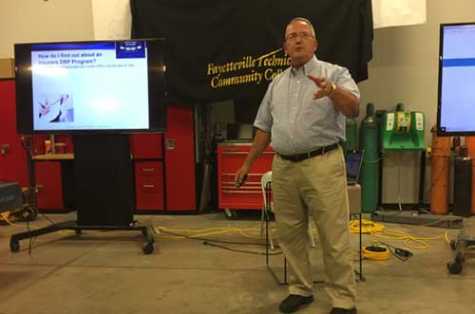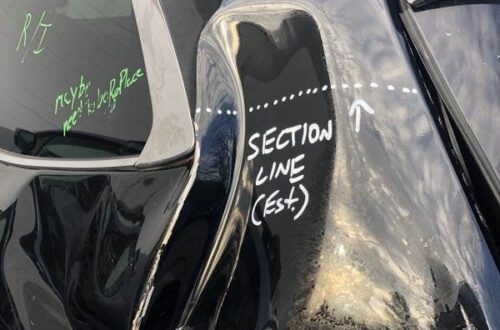Mike Cassata Presents on DRPs at NCACAR 3rd Quarter Meeting
Thursday, 13 September 2018 16:53
Featured in AUTOBODYNEWS

Mike Cassata of Hammer Insights delivered an eye-opening presentation on DRPs during North Carolina Association of Collision and Autobody Repair’s Third Quarter Meeting in Fayetteville, NC, on August 16.
According to NCACAR President Brian Davies, “Our keynote speaker was Mike Cassata, whose main focus was ‘How to Create a World Class Culture to Communicate and Respond to our Clients from an Insurer’s Point of View.’ Mike also spoke on the science behind NPS (Net Promoter Scores) and how it relates to our business. Finally, he spoke about the three C’s: Clear–Complete–Concise. He shared his thoughts on how critical file documentation is to the insurer and repairer and what negative effects it can have on cycle times. If the notes, pictures and documents are not clear, it can create delays in supplemental approvals along with subrogation claims handling.”
Cassata began his presentation by providing insights on DRPs, pointing out that the top 10 insurance carriers by written premiums have approximately 75 percent of the market share, while the top five write 50 percent of market share. All 10 top insurers have aggressive DRPs, continually update their criteria, use a scorecard to measure performance and reward or penalize performance; the scorecard is used to dictate how much work is referred to each shop.
Cassata explained that DRP managers look for shops that have been Gold Class for years, have OEM certifications, employ ASE-certified technicians, have earned industry-leading NPS scores and have clean, comfortable and well-equipped facilities.
“Many shops will not maintain their shop, purchase equipment or train their staff unless required by a DRP partner,” he said. “Better carriers are interested in partnerships with shops who have already embraced these initiatives and are not interested in shops who promise to do so if approved.
“Be sure to weigh the options prior to committing to any DRP relationship. Once you decide that the DRP model is right for your business, you must commit to being all in. If your attitude is that they are a necessary evil and you really dislike them, you will not thrive in this environment. You must train your staff that the insurance partner is just that: a partner and not the enemy. Again, pick your partners wisely.”
To learn about an insurer’s DRP program, shops can contact local appraisers, attend industry events, join associations or contact the DRP manager directly. Researching each carrier before approaching them is imperative as well. Cassata recommended diversification when selecting DRP relationships to pursue.
“Several smaller DRP partners may be better than a few large ones,” he said. “Consider all options—not every carrier is a good fit for your business. Do your homework, and carefully consider the agreement. Read it more than once, question any clause that doesn’t add up, and seek legal counsel. Do not accept a verbal commitment or waiver from a local or national representative.”
When completing a DRP application, shops should be honest about their certifications and equipment, and Cassata reminded attendees that insurers seeking DRP partners are looking for well-equipped, well-trained and properly certified shops. He also stressed the importance of ensuring that office staff has received the proper training.
Turning to equipment requirements, Cassata noted, “Update equipment because it is necessary to provide a quality repair, not because it is required by a DRP program.”
He listed the following as mandatory equipment for most insurers’ DRP partners: federally approved spray booth (waterborne), STRSW welder, MIG welder, MIG brazing welders, aluminum welders, 3D electronic measuring systems and computerized estimating software capable of EMS extract.
Emphasizing the importance of file documentation, Cassata stated, “Your estimate is now an appraisal! Anyone can write an estimate. Learn to write an appraisal of the situation. DRP partners are actually taking the place of the staff or IA. You are writing the appraisal of record, so you have to put on the appraiser’s hat and think like an IA or staff appraiser.
“Follow the carrier’s requirements. Comments and remarks should be restricted to the file only … your personal opinion of the appraiser, customer, vehicle or situation has no place here. This information is discoverable in court. Keep a chronological record of activity. Get good information on YouTube and Collision Hub. Consider I-CAR DOC 01. DRP managers will tell you this can be a bigger problem than quality of the repairs.”
When it comes to file and photo documentation, it’s imperative to be clear and complete.
“Photos must clearly depict damages. All written documentation should be properly punctuated and clearly describe the situation,” Cassata said. “Remember, you are writing an appraisal of the claim, not just a repair estimate.”
If an insurer requests a total loss evaluation, be thorough and include all options and relevant information. Proper photo technique is necessary for the claim file, but some carriers will pay for this service if you ask them.
Cassata reminded attendees, “YOU are the appraiser of record. Fair payment to the policyholder will be based on your report.”
Cassata’s presentation then focused on the importance of the customer as he explained the evolution of a relationship with the customer and the value of developing a connection with them.
In order to deliver outstanding customer service, Cassata recommended, “Be a consultant to your customer. Explain the process. Assist with their insurance claim and their rental. Advise them on the repair process. Make phone calls on their behalf, and help them manage the claim. You are their advocate! You know the process, but it isn’t easy for them.”
Communication via the client’s preferred method leaves a great impression, but customer service begins with the first call to the shop. Ensure friendly greetings as well as a positive first visit to your facility and an overall inviting environment to improve the customer’s experience.
Net Promoter Scores (NPS) ask the ultimate question: How likely is a customer to refer friends and family to this automotive repair facility? Cassata shared useful tips to increase your NPS.
“Don’t ask for a good score, but do ask if there was anything that you could have done better to serve them,” he said. “Tell them they may receive an email or phone call regarding a survey. You should not be in the habit of asking customers to give you a high rating—you should EARN it!”
Cassata also taught attendees how to employ empathy, turn complaints into a gift and develop teamwork that enhances the customer’s experience.
Discussing the difficult decisions that DRP managers must make, Cassata shared many insights.
“Decisions are not made lightly,” he said. “Managers consider all of the facts and do what is ultimately right for the policyholder and the company. This will be discussed with the shop owner and advised why. It’s appreciated when the shop remains professional, and this leaves the door open for the future, but gross structural safety issues was a deal breaker for me and is with many carriers.”
Cassata also covered tips on competing in a consolidating marketplace and the importance of honoring your commitments. He dubbed CCC Open Shop, similar direct communication portals and OEM certifications as the “DRP of the future.”
“Many carriers currently use CCC Open Shop and other direct communication portals to vet future DRP partners, like an audition,” he said. “They won’t tell you this, but the DRP team is monitoring the activity. If you are able to communicate effectively now with the carrier, they may feel you are an excellent candidate for their DRP program. OEM certifications are a must to compete. The vehicle control center will trigger a message to alert the driver to take the vehicle to the nearest OEM-approved collision repair facility and may notify the approved collision facility of the accident.”
It’s imperative for shops to maintain up-to-date, user-friendly websites, and Cassata recommended attending industry events and joining associations as a great way to build DRP relationships.
Cassata concluded, “Finally, it’s a matter of trust. You must be able to trust your insurance partner, and your insurance partner must be able to trust you, but most importantly, your mutual customer must be able to trust the relationship that they have with you and the carrier.”
Davies recalled, “Mike finished up his presentation with a closing thought related to the evolution of our relationship with the customer: ‘A well-treated, well-satisfied first-time customer becomes a repeat customer, and if they have another great experience, they become your client and then your advocate, and then actually feel like your partner and close friend.’”


